Phase Transformation on Two-Dimensional MoTe2 Films for Surface-Enhanced Raman Spectroscopy
Abstract
1. Introduction
2. Results and Discussion
2.1. Characterization of MoTe2 Films
2.2. SERS Performances of MoTe2 Films
2.3. Raman Enhancement Mechanism of MoTe2 Films
3. Experimental Section
3.1. Synthesis of MoTe2 Films
3.2. Characterization
4. Conclusions
Supplementary Materials
Author Contributions
Funding
Institutional Review Board Statement
Informed Consent Statement
Data Availability Statement
Conflicts of Interest
References
- Fleischmann, M.; Hendra, P.J.; Mcquillan, A.J. Raman spectra of pyridine adsorbed at silver electrode. Chem. Phys. Lett. 1974, 26, 163–166. [Google Scholar] [CrossRef]
- Lan, L.; Gao, Y.; Fan, X.; Li, M.; Hao, Q.; Qiu, T. The origin of ultrasensitive SERS sensing beyond plasmonics. Front. Phys. 2021, 16, 43300. [Google Scholar] [CrossRef]
- Itoh, T.; Procházka, M.; Dong, Z.C.; Ji, W.; Yamamoto, Y.S.; Zhang, Y.; Ozaki, Y. Toward a new era of SERS and TERS at the nanometer scale: From fundamentals to innovative applications. Chem. Rev. 2023, 123, 1552–1634. [Google Scholar] [CrossRef] [PubMed]
- Zhang, Y.; Ye, Z.; Li, C.; Chen, Q.; Aljuhani, W.; Huang, Y.; Xu, X.; Wu, C.; Bell, S.E.; Xu, Y. General approach to surface-accessible plasmonic Pickering emulsions for SERS sensing and interfacial catalysis. Nat. Commun. 2023, 14, 1392. [Google Scholar] [CrossRef]
- Li, H.; Dumont, E.; Slipets, R.; Thersleff, T.; Boisen, A.; Sotiriou, G.A. Democratizing robust SERS nano-sensors for food safety diagnostics. Chem. Eng. J. 2023, 470, 144023. [Google Scholar] [CrossRef]
- Tang, X.; Hao, Q.; Hou, X.; Lan, L.; Li, M.; Yao, L.; Zhao, X.; Ni, Z.; Fan, X.; Qiu, T. Exploring and Engineering 2D Transition Metal Dichalcogenides toward Ultimate SERS Performance. Adv. Mater. 2024, 36, 2312348. [Google Scholar] [CrossRef]
- Ding, S.Y.; Yi, J.; Li, J.F.; Ren, B.; Wu, D.Y.; Panneerselvam, R.; Tian, Z.Q. Nanostructure-based plasmon-enhanced Raman spectroscopy for surface analysis of materials. Nat. Rev. Mater. 2016, 1, 1–16. [Google Scholar] [CrossRef]
- Xu, W.; Mao, N.; Zhang, J. Graphene: A platform for surface-enhanced Raman spectroscopy. Small 2013, 9, 1206–1224. [Google Scholar] [CrossRef]
- Rajput, V.; Gupta, R.K.; Prakash, J. Engineering metal oxide semiconductor nanostructures for enhanced charge transfer: Fundamentals and emerging SERS applications. J. Mater. Chem. C 2022, 10, 73–95. [Google Scholar]
- Lan, L.; Hou, X.; Gao, Y.; Fan, X.; Qiu, T. Inkjet-printed paper-based semiconducting substrates for surface-enhanced Raman spectroscopy. Nanotechnology 2020, 31, 055502. [Google Scholar] [CrossRef]
- Lan, L.; Fan, X.; Yu, S.; Gao, J.; Zhao, C.; Hao, Q.; Qiu, T. Flexible two-dimensional vanadium carbide MXene-based membranes with ultra-rapid molecular enrichment for surface-enhanced Raman scattering. ACS Appl. Mater. Interfaces 2022, 14, 40427–40436. [Google Scholar] [CrossRef]
- Lan, L.; Fan, X.; Zhao, C.; Gao, J.; Qu, Z.; Song, W.; Yao, H.; Li, M.; Qiu, T. Two-dimensional MBenes with ordered metal vacancies for surface-enhanced Raman scattering. Nanoscale 2023, 15, 2779–2787. [Google Scholar] [CrossRef]
- Sun, H.; Cong, S.; Zheng, Z.; Wang, Z.; Chen, Z.; Zhao, Z. Metal–organic frameworks as surface enhanced Raman scattering substrates with high tailorability. J. Am. Chem. Soc. 2018, 141, 870–878. [Google Scholar] [CrossRef]
- Yu, Z.; Yu, W.; Xing, J.; Ganeev, R.A.; Xin, W.; Cheng, J.; Guo, C. Charge transfer effects on resonance-enhanced Raman scattering for molecules adsorbed on single-crystalline perovskite. ACS Photonics 2018, 5, 1619–1627. [Google Scholar] [CrossRef]
- Zhang, L.; Yi, W.; Li, J.; Wei, G.; Xi, G.; Mao, L. Surfactant-free interfacial growth of graphdiyne hollow microspheres and the mechanistic origin of their SERS activity. Nat. Commun. 2023, 14, 6318. [Google Scholar] [CrossRef]
- Demirel, G.; Gieseking, R.L.; Ozdemir, R.; Kahmann, S.; Loi, M.A.; Schatz, G.C.; Facchetti, A.; Usta, H. Molecular engineering of organic semiconductors enables noble metal-comparable SERS enhancement and sensitivity. Nat. Commun. 2019, 10, 5502. [Google Scholar] [CrossRef]
- Yin, Y.; Miao, P.; Zhang, Y.; Han, J.; Zhang, X.; Gong, Y.; Gu, L.; Xu, C.; Yao, T.; Xu, P.; et al. Significantly increased Raman enhancement on MoX2 (X = S, Se) monolayers upon phase transition. Adv. Funct. Mater. 2017, 27, 1606694. [Google Scholar] [CrossRef]
- Zhang, Y.; Chen, W.; Fu, T.; Sun, J.; Zhang, D.; Li, Y.; Zhang, S.; Xu, H. Simultaneous surface-enhanced resonant Raman and fluorescence spectroscopy of monolayer MoSe2: Determination of ultrafast decay rates in nanometer dimension. Nano Lett. 2019, 19, 6284–6291. [Google Scholar] [CrossRef]
- Tao, L.; Chen, K.; Chen, Z.; Cong, C.; Qiu, C.; Chen, J.; Wang, X.; Chen, H.; Yu, T.; Xie, W.; et al. 1T′ transition metal telluride atomic layers for plasmon-free SERS at femtomolar levels. J. Am. Chem. Soc. 2018, 140, 8696–8704. [Google Scholar] [CrossRef]
- Guan, Y.; Chen, M.; Ding, Y.; Fang, Y.; Huang, F.; Xu, C.Y.; Zhen, L.; Li, Y.; Yang, L.; Xu, P. Phase transformation on multilayer 2M-WS2 for improved surface-enhanced Raman scattering. ACS Nano 2024, 18, 17339–17348. [Google Scholar] [CrossRef]
- Lv, Q.; Tan, J.; Wang, Z.; Yu, L.; Liu, B.; Lin, J.; Li, J.; Huang, Z.H.; Kang, F.; Lv, R. Femtomolar-level molecular sensing of monolayer tungsten diselenide induced by heteroatom doping with long-term stability. Adv. Funct. Mater. 2022, 32, 2200273. [Google Scholar] [CrossRef]
- Ge, Y.; Wang, F.; Yang, Y.; Xu, Y.; Ye, Y.; Cai, Y.; Zhang, Q.; Cai, S.; Jiang, D.; Liu, X.; et al. Atomically thin TaSe2 film as a high-performance substrate for surface-enhanced Raman scattering. Small 2022, 18, 2107027. [Google Scholar] [CrossRef]
- Song, X.; Wang, Y.; Zhao, F.; Li, Q.; Ta, H.Q.; Rümmeli, M.H.; Tully, C.G.; Li, Z.; Yin, W.J.; Yang, L.; et al. Plasmon-free surface-enhanced Raman spectroscopy using metallic 2D materials. ACS Nano 2019, 13, 8312–8319. [Google Scholar] [CrossRef]
- Meng, L.; Hu, S.; Xu, C.; Wang, X.; Li, H.; Yan, X. Surface enhanced Raman effect on CVD growth of WS2 film. Chem. Phys. Lett. 2018, 707, 71–74. [Google Scholar] [CrossRef]
- Tang, X.; Fan, X.; Zhou, J.; Wang, S.; Li, M.; Hou, X.; Jiang, K.; Ni, Z.; Zhao, B.; Hao, Q.; et al. Alloy engineering allows on-demand design of ultrasensitive monolayer semiconductor SERS substrates. Nano Lett. 2023, 23, 7037–7045. [Google Scholar] [CrossRef]
- Li, M.; Wei, Y.; Fan, X.; Li, G.; Hao, Q.; Qiu, T. Mixed-dimensional van der Waals heterojunction-enhanced Raman scattering. Nano Res. 2022, 15, 637–643. [Google Scholar] [CrossRef]
- Lan, L.; Yao, H.; Li, G.; Fan, X.; Li, M.; Qiu, T. Structural engineering of transition-metal nitrides for surface-enhanced Raman scattering chips. Nano Res. 2022, 15, 3794–3803. [Google Scholar] [CrossRef]
- Xu, X.; Pan, Y.; Liu, S.; Han, B.; Gu, P.; Li, S.; Xu, W.; Peng, Y.; Han, Z.; Chen, J.; et al. Seeded 2D epitaxy of large-area single-crystal films of the van der Waals semiconductor 2H MoTe2. Science 2021, 372, 195–200. [Google Scholar] [CrossRef]
- Sun, L.; Ding, M.; Li, J.; Yang, L.; Lou, X.; Xie, Z.; Zhang, W.; Chang, H. Phase-controlled large-area growth of MoTe2 and MoTe2−xOx/MoTe2 heterostructures for tunable memristive behavior. Appl. Surf. Sci. 2019, 496, 143687. [Google Scholar] [CrossRef]
- Vishwanath, S.; Sundar, A.; Liu, X.; Azcatl, A.; Lochocki, E.; Woll, A.R.; Rouvimov, S.; Hwang, W.S.; Lu, N.; Peng, X.; et al. MBE growth of few-layer 2H-MoTe2 on 3D substrates. J. Cryst. Growth 2018, 482, 61–69. [Google Scholar] [CrossRef]
- Arévalo-López, E.P.; Romero-Moreno, P.; Rosas-Huerta, J.L.; Huerta, L.; Minaud, C.; Marquina, M.L.; Escamilla, R.; Romero, M. Effect of Fe on Bi2Te3: Structure, magnetic properties, and XPS valence band. J. Alloys Compd. 2022, 899, 163297. [Google Scholar] [CrossRef]
- Kim, T.; Park, H.; Joung, D.; Kim, D.; Lee, R.; Shin, C.H.; Diware, M.; Chegal, W.; Jeong, S.H.; Shin, J.C.; et al. Wafer-scale epitaxial 1T′, 1T′-2H mixed, and 2H phases MoTe2 thin films grown by metal-organic chemical vapor deposition. Adv. Mater. Interfaces 2018, 5, 1800439. [Google Scholar] [CrossRef]
- Lan, L.; Yang, S.; Li, G.; Zhao, C.; Liu, J.; Tang, X.; Zhao, X.; Qu, Z.; Gao, J.; Fan, X.; et al. Direct writing of flexible two-dimensional MXene arrays for SERS sensing. J. Mater. Chem. C 2024, 12, 12115–12123. [Google Scholar] [CrossRef]
- Lan, L.; Ni, Z.; Zhao, C.; Gao, J.; Tang, X.; Qu, Z.; Zheng, L.; Fan, X.; Qiu, T. Photoinduced charge transfer empowers Ta4C3 and Nb4C3 MXenes with high SERS performance. Langmuir 2024, 40, 20945–20953. [Google Scholar] [CrossRef]
- Liang, C.; Lu, Z.A.; Zheng, M.; Cheng, M.X.; Zhang, Y.Y.; Zhang, B.; Zhang, J.X.; Xu, P. Band structure engineering within two-dimensional borocarbonitride nanosheets for surface-enhanced Raman scattering. Nano Lett. 2022, 22, 6590–6598. [Google Scholar] [CrossRef]
- Zhao, S.; Wang, H.; Niu, L.; Xiong, W.; Chen, Y.; Zeng, M.; Yuan, S.; Fu, L. 2D GaN for highly reproducible surface enhanced Raman scattering. Small 2021, 17, 2103442. [Google Scholar] [CrossRef]
- Li, Y.; Chen, H.; Guo, Y.; Wang, K.; Zhang, Y.; Lan, P.; Guo, J.; Zhang, W.; Zhong, H.; Guo, Z.; et al. Lamellar hafnium ditelluride as an ultrasensitive surface-enhanced Raman scattering platform for label-free detection of uric acid. Photonics Res. 2021, 9, 1039–1047. [Google Scholar] [CrossRef]
- Shao, M.; Ji, C.; Tan, J.; Du, B.; Zhao, X.; Yu, J.; Man, B.; Xu, K.; Zhang, C.; Li, Z. Ferroelectrically modulate the Fermi level of graphene oxide to enhance SERS response. Opto-Electron. Adv. 2023, 6, 230094. [Google Scholar] [CrossRef]
- Wang, L.; Yu, D.; Huang, B.; Ou, Z.; Tao, L.; Tao, L.; Zheng, Z.; Liu, J.; Yang, Y.; Wei, A.; et al. Large-area ReS2 monolayer films on flexible substrate for SERS based molecular sensing with strong fluorescence quenching. Appl. Surf. Sci. 2021, 542, 148757. [Google Scholar] [CrossRef]
- Liang, E.J.; Ye, X.L.; Kiefer, W. Surface-enhanced Raman spectroscopy of crystal violet in the presence of halide and halate ions with near-infrared wavelength excitation. J. Phys. Chem. A 1997, 101, 7330–7335. [Google Scholar] [CrossRef]
- Biswal, B.; Mishra, S.B.; Yadav, R.; Poudyal, S.; Rajarapu, R.; Barman, P.K.; Pandurang, K.R.; Mandal, M.; Singh, R.P.; Nanda, B.R.K.; et al. Work function of van der Waals topological semimetals: Experiment and theory. Appl. Phys. Lett. 2022, 120, 093101. [Google Scholar] [CrossRef]
- Shao, C.; Ren, K.; Huang, Z.; Yang, J.; Cui, Z. Two-dimensional PtS2/MoTe2 van der Waals heterostructure: An efficient potential photocatalyst for water splitting. Front. Chem. 2022, 10, 847319. [Google Scholar] [CrossRef] [PubMed]
- Lv, Q.; Wu, X.; Tan, J.; Liu, B.; Gan, L.; Li, J.; Huang, Z.H.; Kang, F.; Lv, R. Ultrasensitive molecular sensing of few-layer niobium diselenide. J. Mater. Chem. A 2021, 9, 2725–2733. [Google Scholar] [CrossRef]

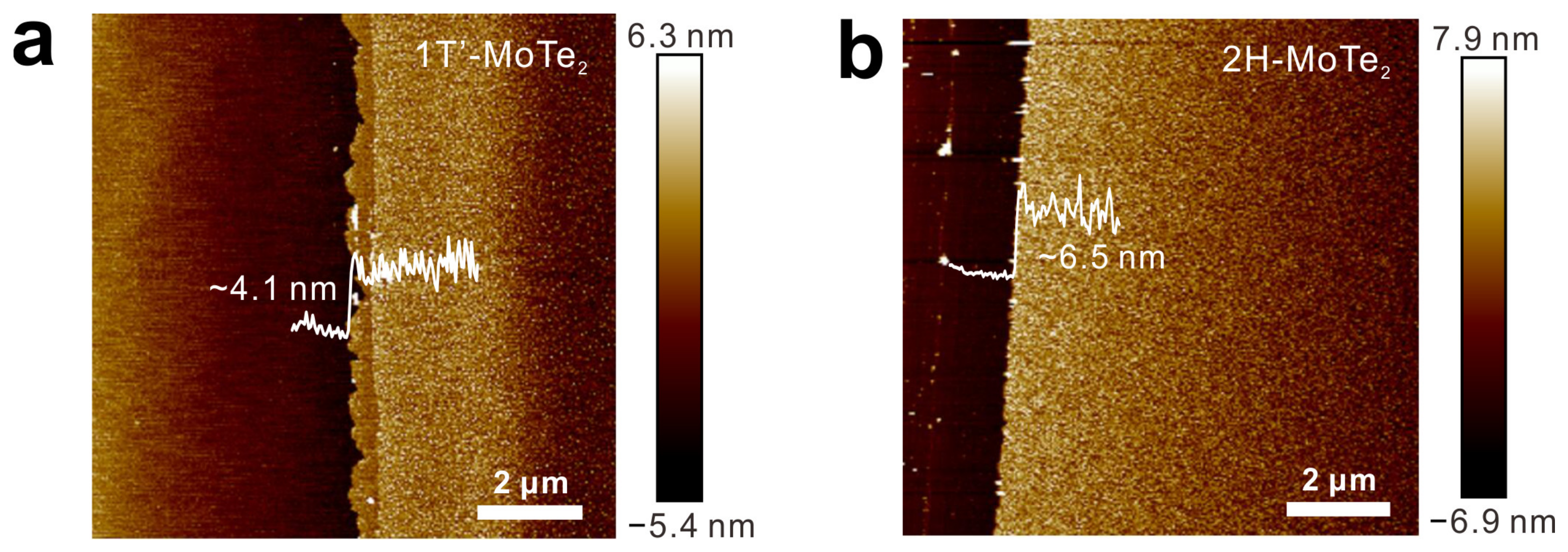
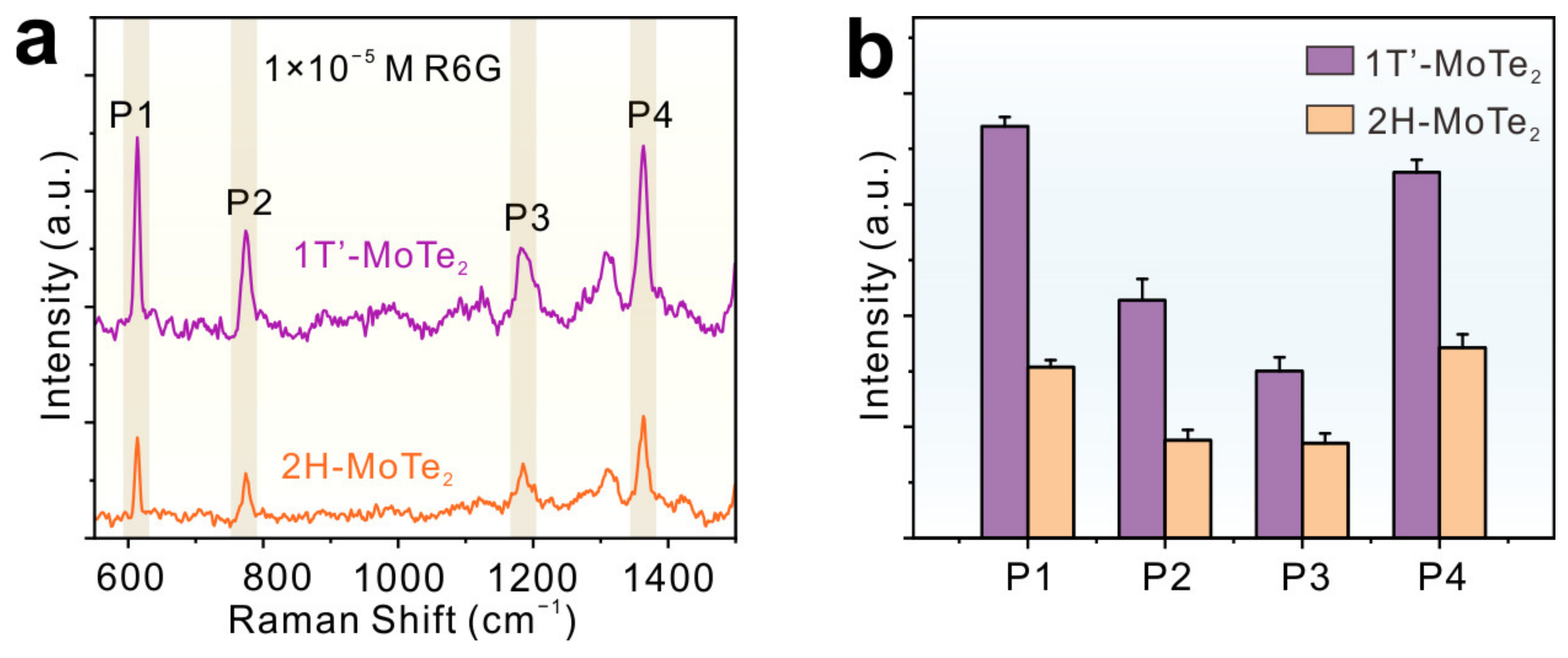
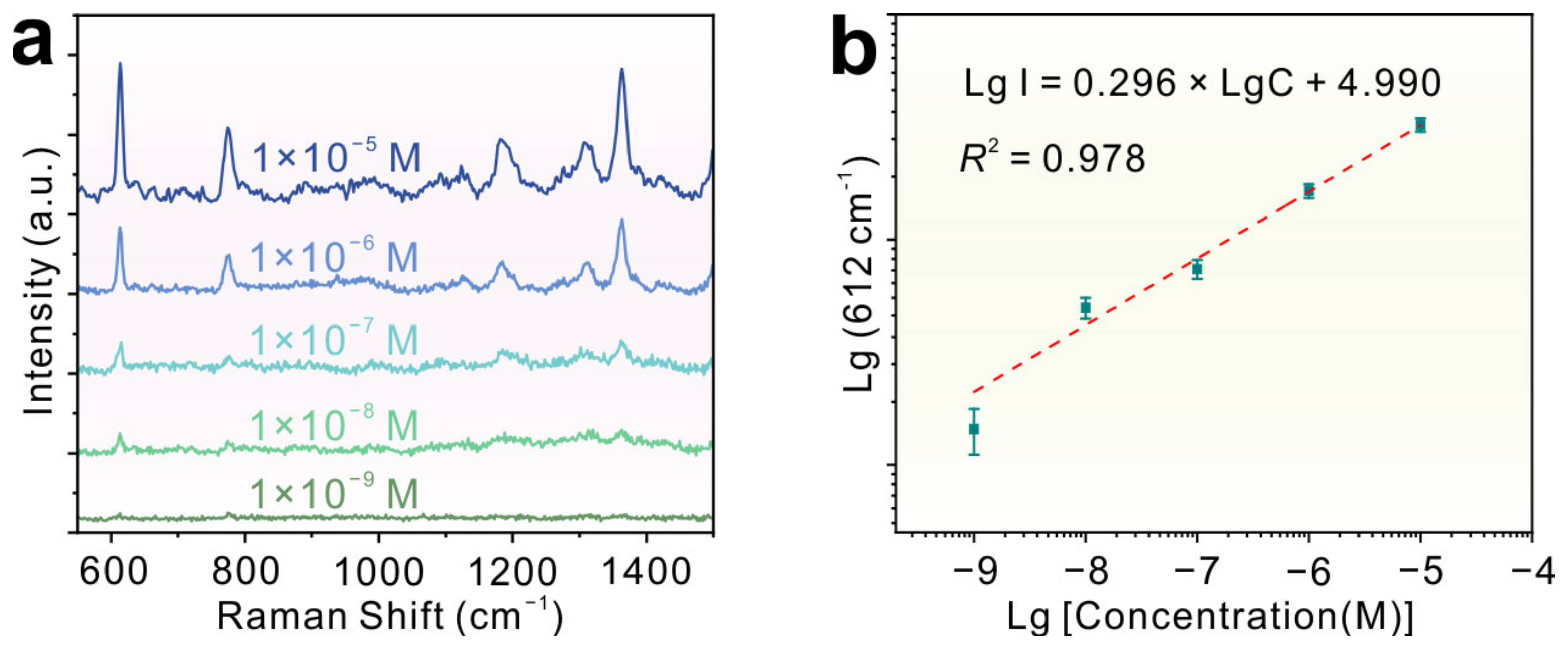
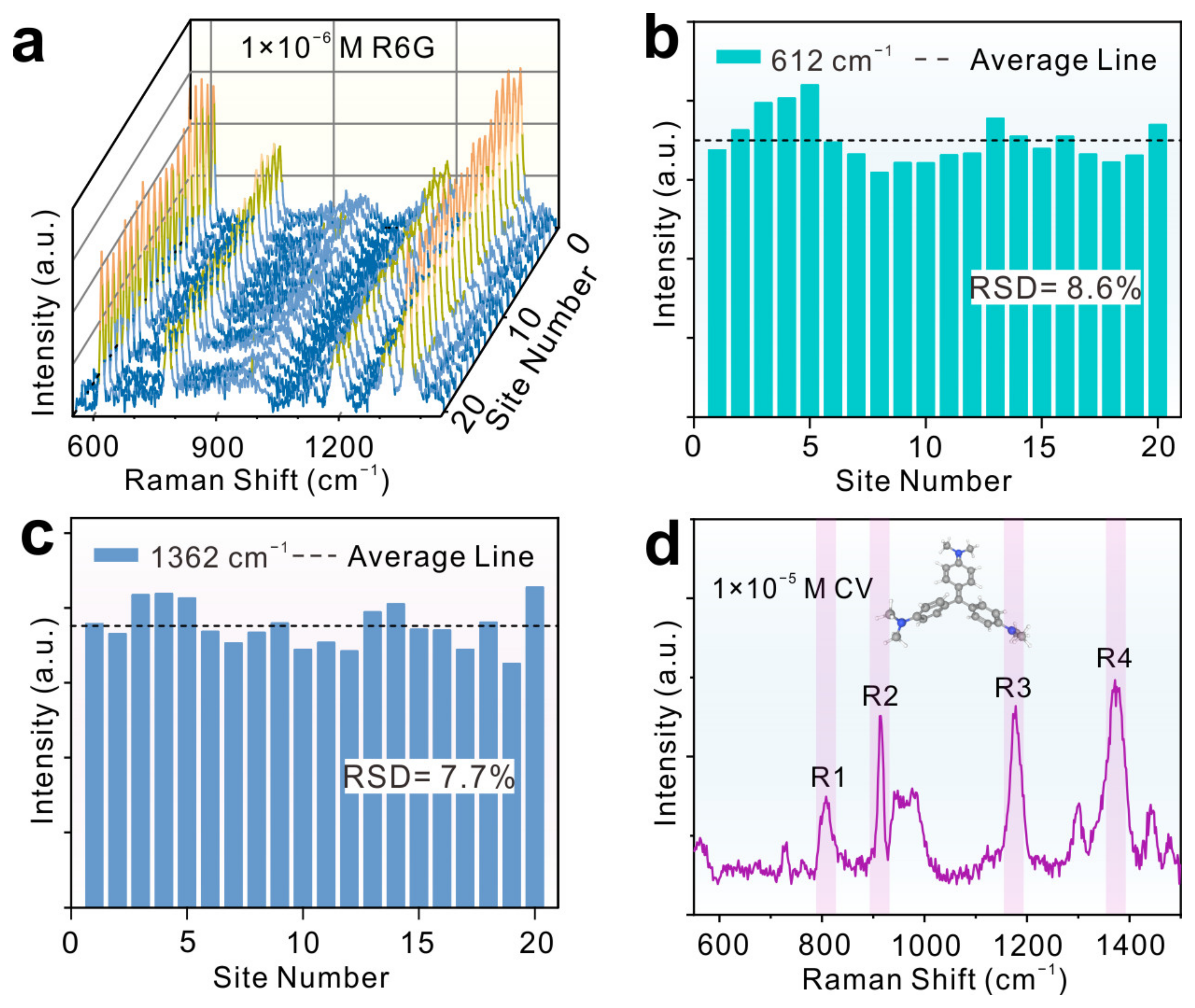
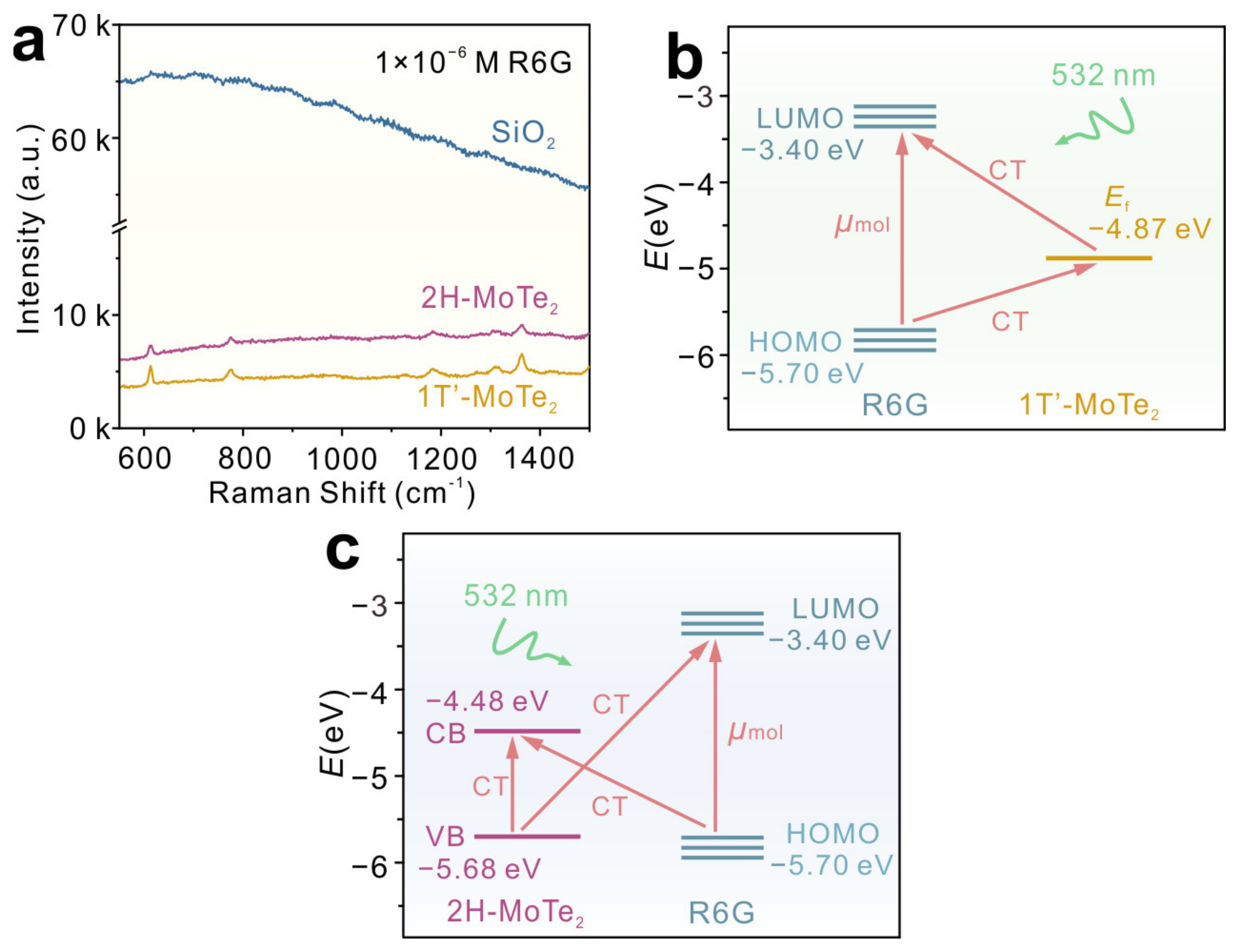

Disclaimer/Publisher’s Note: The statements, opinions and data contained in all publications are solely those of the individual author(s) and contributor(s) and not of MDPI and/or the editor(s). MDPI and/or the editor(s) disclaim responsibility for any injury to people or property resulting from any ideas, methods, instructions or products referred to in the content. |
© 2024 by the authors. Licensee MDPI, Basel, Switzerland. This article is an open access article distributed under the terms and conditions of the Creative Commons Attribution (CC BY) license (https://creativecommons.org/licenses/by/4.0/).
Share and Cite
Zhao, C.; Huang, J. Phase Transformation on Two-Dimensional MoTe2 Films for Surface-Enhanced Raman Spectroscopy. Molecules 2024, 29, 5216. https://doi.org/10.3390/molecules29215216
Zhao C, Huang J. Phase Transformation on Two-Dimensional MoTe2 Films for Surface-Enhanced Raman Spectroscopy. Molecules. 2024; 29(21):5216. https://doi.org/10.3390/molecules29215216
Chicago/Turabian StyleZhao, Caiye, and Junwen Huang. 2024. "Phase Transformation on Two-Dimensional MoTe2 Films for Surface-Enhanced Raman Spectroscopy" Molecules 29, no. 21: 5216. https://doi.org/10.3390/molecules29215216
APA StyleZhao, C., & Huang, J. (2024). Phase Transformation on Two-Dimensional MoTe2 Films for Surface-Enhanced Raman Spectroscopy. Molecules, 29(21), 5216. https://doi.org/10.3390/molecules29215216





